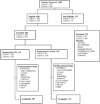Confronting challenges in intervention research with ethnically diverse older adults: the USC Well Elderly II Trial
- PMID: 19254939
- PMCID: PMC3073495
- DOI: 10.1177/1740774508101191
Confronting challenges in intervention research with ethnically diverse older adults: the USC Well Elderly II Trial
Abstract
Background: Community-dwelling older adults are at risk for declines in physical health, cognition, and psychosocial well-being. However, their enactment of active and health-promoting lifestyles can reduce such declines.
Purpose: The purpose of this article is to describe the USC Well Elderly II study, a randomized clinical trial designed to test the effectiveness of a healthy lifestyle program for elders, and document how various methodological challenges were addressed during the course of the trial.
Methods: In the study, 460 ethnically diverse elders recruited from a variety of sites in the urban Los Angeles area were enrolled in a randomized experiment involving a crossover design component. Within either the first or second 6-month phase of their study involvement, each elder received a lifestyle intervention designed to improve a variety of aging outcomes. At 4-5 time points over an 18-24 month interval, the research participants were assessed on measures of healthy activity, coping, social support, perceived control, stress-related biomarkers, perceived physical health, psychosocial well-being, and cognitive functioning to test the effectiveness of the intervention and document the process mechanisms responsible for its effects.
Results: The study protocol was successfully implemented, including the enrollment of study sites, the recruitment of 460 older adults, administration of the intervention, adherence to the plan for assessment, and establishment of a large computerized data base.
Limitations: Methodological challenges were encountered in the areas of site recruitment, participant recruitment, testing, and intervention delivery.
Conclusions: The completion of clinical trials involving elders from numerous local sites requires careful oversight and anticipation of threats to the study design that stem from: (a) social situations that are particular to specific study sites; and (b) physical, functional, and social challenges pertaining to the elder population.
Figures



References
-
- Martin I, Grotewiel MS. Oxidative damage and age-related functional declines. Mech Ageing Dev. 2006;127:411–423. - PubMed
-
- Burke SN, Barnes CA. Neural plasticity in the ageing brain. Nat Rev Neurosci. 2006;7:30–40. - PubMed
-
- Hedden T, Gabrieli JDE. Insights into the ageing mind: a view from cognitive neuroscience. Nat Rev Neurosci. 2004;5:87–96. - PubMed
-
- Smith J, Borchelt M, Maier H, Jopp D. Health and well-being in the young old and oldest old. J Soc Issues. 2002;4:715–732.
-
- U.S. Department of Commerce, Economics and Statistics Administration. Washington, DC: U.S. Census Bureau; 1995. [updated 2001 July 27; cited 2007 May 15]. Sixty-five plus in the United States. [document on the internet]. Available from: http://www.census.gov/population/socdemo/statbriefs/agebrief.html.
Publication types
MeSH terms
Grants and funding
LinkOut - more resources
Full Text Sources

